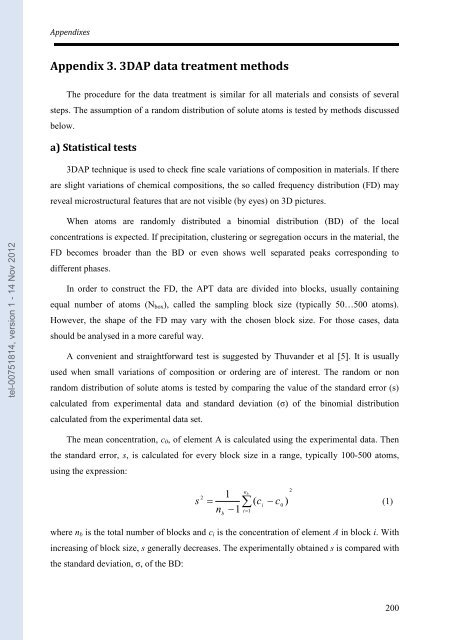Etude par Sonde Atomique Tomographique de la formation de nano ...
Etude par Sonde Atomique Tomographique de la formation de nano ...
Etude par Sonde Atomique Tomographique de la formation de nano ...
Create successful ePaper yourself
Turn your PDF publications into a flip-book with our unique Google optimized e-Paper software.
tel-00751814, version 1 - 14 Nov 2012<br />
Appendixes<br />
Appendix 3. 3DAP data treatment methods<br />
The procedure for the data treatment is simi<strong>la</strong>r for all materials and consists of several<br />
steps. The assumption of a random distribution of solute atoms is tested by methods discussed<br />
below.<br />
a) Statistical tests<br />
3DAP technique is used to check fine scale variations of composition in materials. If there<br />
are slight variations of chemical compositions, the so called frequency distribution (FD) may<br />
reveal microstructural features that are not visible (by eyes) on 3D pictures.<br />
When atoms are randomly distributed a binomial distribution (BD) of the local<br />
concentrations is expected. If precipitation, clustering or segregation occurs in the material, the<br />
FD becomes broa<strong>de</strong>r than the BD or even shows well se<strong>par</strong>ated peaks corresponding to<br />
different phases.<br />
In or<strong>de</strong>r to construct the FD, the APT data are divi<strong>de</strong>d into blocks, usually containing<br />
equal number of atoms (Nbox), called the sampling block size (typically 50…500 atoms).<br />
However, the shape of the FD may vary with the chosen block size. For those cases, data<br />
should be analysed in a more careful way.<br />
A convenient and straightforward test is suggested by Thuvan<strong>de</strong>r et al [5]. It is usually<br />
used when small variations of composition or or<strong>de</strong>ring are of interest. The random or non<br />
random distribution of solute atoms is tested by com<strong>par</strong>ing the value of the standard error (s)<br />
calcu<strong>la</strong>ted from experimental data and standard <strong>de</strong>viation (σ) of the binomial distribution<br />
calcu<strong>la</strong>ted from the experimental data set.<br />
The mean concentration, c0, of element A is calcu<strong>la</strong>ted using the experimental data. Then<br />
the standard error, s, is calcu<strong>la</strong>ted for every block size in a range, typically 100-500 atoms,<br />
using the expression:<br />
1 ��<br />
n<br />
2<br />
b<br />
2<br />
s � ( c � c )<br />
(1)<br />
i 0<br />
n �1<br />
i 1<br />
b<br />
where nb is the total number of blocks and ci is the concentration of element A in block i. With<br />
increasing of block size, s generally <strong>de</strong>creases. The experimentally obtained s is com<strong>par</strong>ed with<br />
the standard <strong>de</strong>viation, σ, of the BD:<br />
200

















